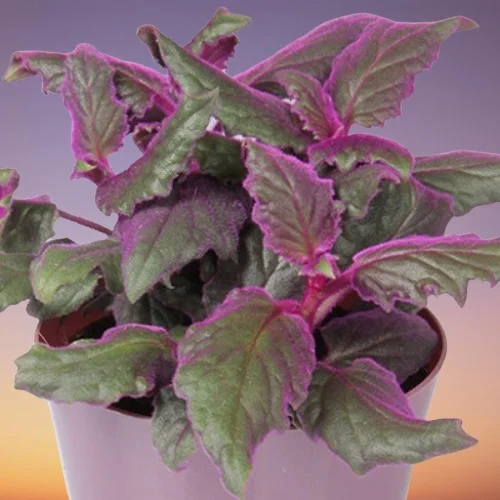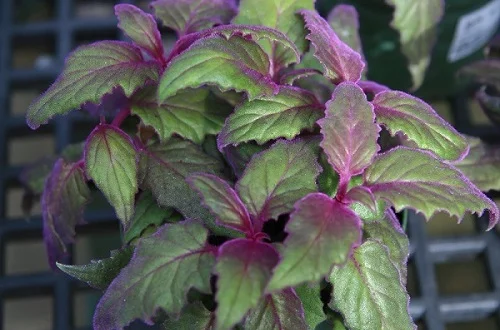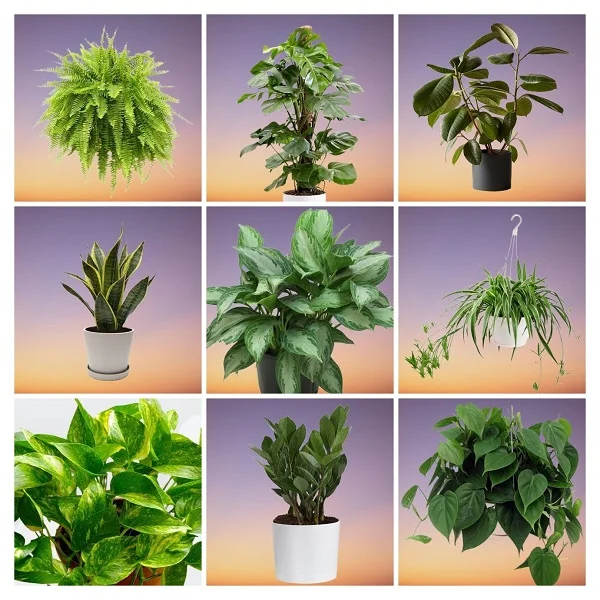Purple Passion Plant (Gynura) Care Indoors, Propagation and Common Problems
Some links in this post may be affiliate links
Purple Passion Plant (Gynura) blossoms in bright light with some direct sunlight, average warmth, humid conditions and moderately moist, rich, well-drained, all purpose soil coupled with fortnightly feeding in the growing season.
Gynura also called Velvet Plant is a popular, trailing plant whose foliage is covered with shiny purple hairs and is perfect for adding a splash of color in any space. It is one of the magnficent purple-leaved plants.
Velvet Plants are easy-care, fast-growing plants whose shiny purple hairs on the foliage impart a velvety feel to the plants, hence, the common name.
Gynura Plants produce small dandelion-like flowers which have a rather offensive smell and need to be removed at the bud stage.
Like the delightful Piggyback Plant (Tolmiea menziesii), Purple Passion Plant is one of the best plants for a hanging basket.

Botanical name: Gynura
Family: Asteraceae
Common names: Purple Passion Plant, Velvet Plant
Origin
Gynura genus (Purple Passion plants) belong to the family Asteraceae and are native to Asia.
Varieties
Only a few species of the Gynura genus are grown indoors. One of them is Gynura sarmentosa, which is a trailer, whose foliage is gleaming purple in bright light and is ideal for a hanging basket.
Gynura aurantiaca, has larger leaves and is more upright. Gynura procumbens (Longevity Spinach), which is a trailer, whose leaves are deep burgundy colored at the bottom and is ideal for a hanging basket.
Toxicity
Purple Passion Plant is non-toxic to both humans and pets as indicated by ASPCA. However, it may cause allergic skin reactions to people with sensitive skin. Always wear gloves when handling the plant.
Related: 15 Indoor Plants that are Safe for Cats and Dogs
Where to Buy
If you are looking to add these pretty plants to your collection. They are available online on Etsy (Link to Etsy).
Purple Passion Plant Care Indoors
Purple Passion Plant (Gynura) flourishes in bright light with 4-6 hours of sunlight, average warmth of 15-260C, humidity of 60-70% and moderately moist, fertile, well-drained, all purpose soil coupled with fortnightly feeding during the growing season.
Gynura Plant requires annual repotting and regular pruning to keep it neat as well as encourage a bushy growth. Keep reading for more on these growing conditions and how to achieve them.

Gynura aurantiaca
Light Requirements
Purple Passion Plant grows best in bright light with 4-6 hours of direct sunlight to enhance leaf color. Shield the plant from hot midday sunshine as it can scorch the leaves.
Gynura may be grown under grow lights if the natural light is not sufficient. Check out these full spectrum grow lights on Amazon.
Regularly rotate the pot to ensure that the Velvet Plant gets adequate light on all sides to prevent lopsided growth.
Watering
Water Purple Passion Plant thoroughly during the growing season while allowing the top 2-3 inches of soil to dry a little between waterings to keep the soil moderately moist.
Lessen watering during the cold period to maintain the soil slightly moist but do not allow the soil to dry out completely.
Ensure that the pot has a drainage hole to prevent the soil from getting soggy as it can lead to root-rot and death of the plant. Learn more on how to water houseplants correctly.
Temperature and Humidity
Purple Passion Plant prefers average warmth of 15-260C. Protect it from cold and hot drafts to avoid sudden changes in temperature as they can cause reduced growth and eventual death of the plant.
Purple Passion Plant needs a humidity of 60-70% for lush growth as well as reduce pest infestations. Set the pot on a wet pebble tray or use a cool mist humidifier to increase humidity. Read more on how to raise humidity for indoor plants.
Clean the leaves by gently brushing off the dust with a soft brush but do not wash with water as it can be trapped between the hairs and thereby cause fungal disease infestations.
Fertilizer
Feed Purple Passion Plant every 2-3 weeks during the growing season with a balanced, liquid fertilizer to promote a lush growth. Stop feeding in the cold season as growth is minimal at this time.
Potting Soil
The best soil for Purple Passion Plant should be rich in organic matter and free-draining to prevent it from getting soggy while providing the required nutrients. All purpose potting mixes are ideal for this plant.
Repotting
Repot Purple Passion Plant every year during the growing period. Use a pot which is 1 size larger than the current one and free-draining soil that is rich in organic matter. Make sure that the pot has a drainage hole to prevent the soil from getting soggy as it can lead to root-rot. Check out these pots with drainage holes on Amazon.
Pruning
Pruning Purple Passion Plant involves removal of yellow and dead leaves to maintain the plant neat and discourage pest and disease infestations. To encourage a bushy and compact growth, pinch off the growing tips. The tips can be used to propagate new plants.
Remove the flower buds as soon as they appear to avoid having the offensive smell of the flowers. Cutback leggy stems at the beginning of the growing season to rejuvenate growth and also encourage a compact growth.
Propagation
Purple Passion Plant (Gynura) is propagated at the beginning of the growing season from stem cuttings. The stem cuttings can be rooted in soil or in water.
How to root Purple Passion Plant stem cuttings in soil
Take stem cuttings of about 4-5 inches length from a healthy Purple Passion Plant and insert them in moist free-draining soil.
Place the set up in warm, well-lit place and maintain the soil moist until new growth emerges and substantial growth has been observed.
Transfer the rooted Velvet Plant cuttings to individual pots and begin routine care. For a fuller plant, transfer several cuttings in one pot.
How to root Purple Passion Plant stem cuttings in water
Take cuttings of about 4-5 inches length from a healthy Purple Passion Plant and place them in a jar of plain water. Place the set up in a well-lit spot and change the water every 5-7 days.
When a good amount of roots have formed, transfer the cuttings in moist free-draining soil.
Position the set up in a warm, well-lit place and maintain the soil moist until new growth has emerged and substantial growth has been observed.
Transfer the rooted cuttings to individual pots and begin routine care. For a fuller Gynura Plant, transfer several cuttings into one pot.

Gynura sarmentosa
Purple Passion Plant Problems
Purple Passion Plant (Gynura) problems include leggy growth, brown leaf tips, loss of leaf color, drooping leaves, pests and diseases among others. Keep reading for more on these problems and how to fix them.
Pests
Purple Passion Plant pests are spider mites, scale insects and aphids. Isolate the affected plant to prevent spread to the rest of the plants. Treat it with neem oil as per the manufacturer's recommendations.
Diseases
Purple Passion Plant is prone to root-rot which is prevalent in soggy soil brought about by poor soil drainage. Always ensure that the pot has a drainage hole and that the soil drains easily to prevent it from getting soggy. Learn how to treat root-rot in houseplants.
Undersized leaves and leggy growth
Purple Passion Plant bearing undersized leaves and showing leggy growth is receiving too little light. Move the plant to a brighter spot where it will receive bright light with 4-6 hours direct sunlight or instal a grow light if the natural light is not sufficient. Check out this guide on understanding light for houseplants.
Brown, dry leaf tips and edges
Purple Passion Plant brown leaves, dry leaf tips and edges and shows stunted growth are signs of spider mites infestation due to the air being too dry. Set the pot on a wet pebble tray or use a cool mist humidifier to elevate humidity to discourage the pests. Remove dead growth also to reduce their breeding ground.
Drooping leaves
Purple Passion Plant drooping leaves are due to underwatering. Water the plant immediately and it should perk up.Thereafter, ensure that the soil is moderately moist during the growing season and slightly moist in the cold period but never allow the soil to dry out completely.
Loss of leaf color
Loss of leaf color in Purple Passion Plant is caused by too little light. Move it to a brighter spot and ensure it receives bright light with some direct sunshine to enhance leaf color.
You liked it? Share on social media.
Related Content
Amazon Associates Disclosure
Homeplantsguide.com is a participant in the Amazon Services LLC Associates Program, an affiliate advertising program designed to provide a means for sites to earn advertising fees by advertising and linking to amazon.com.





